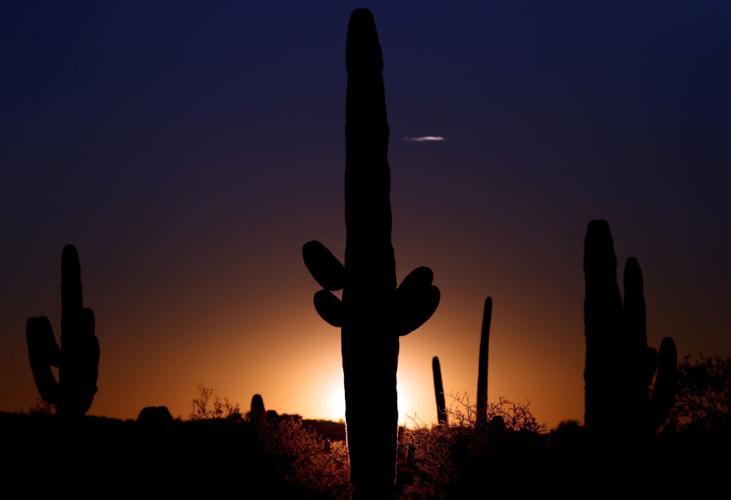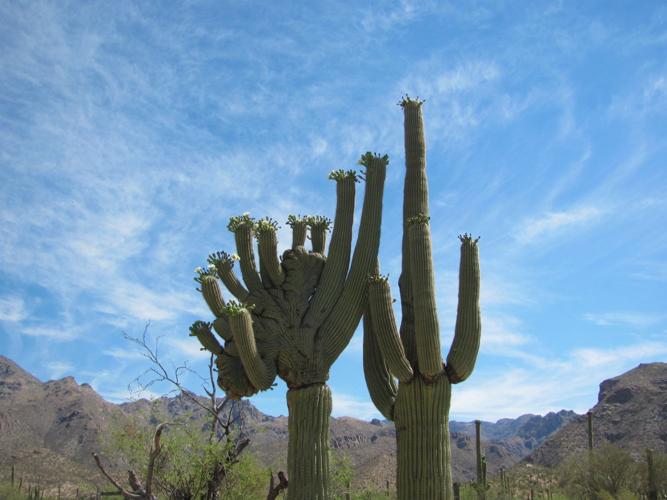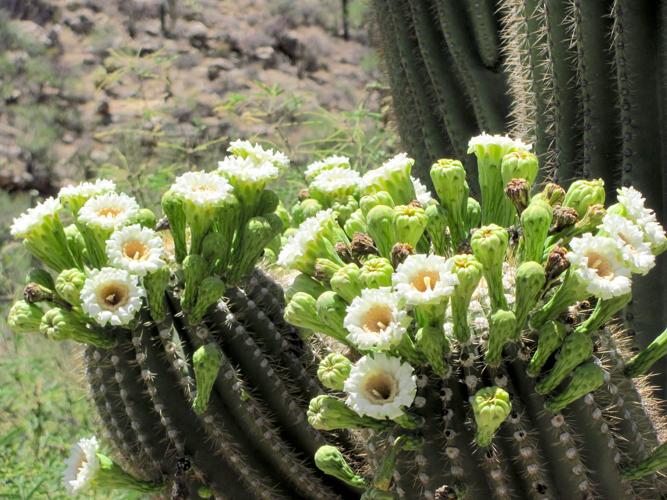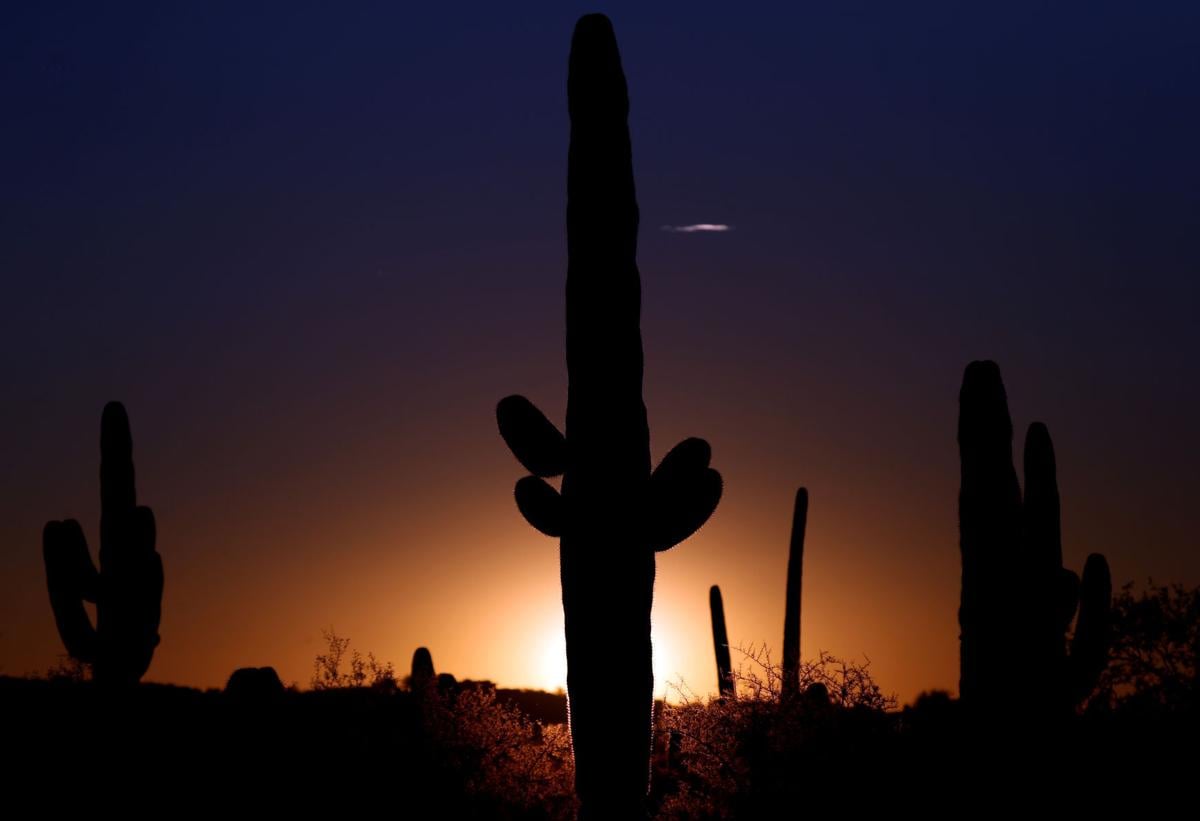Editor's note: This story was originally published on May 20, 2021 and updated on June 26, 2022.
It was all eyes on saguaros recently as our beloved desert plants sprouted green buds giving way to creamy white blossoms.
"I've been looking at saguaros for a long time and I never get tired of it," says Don Swann, who has worked as a biologist at Saguaro National Park since 1993. "As someone who does science with saguaros and works with scientists I'm always surprised at how we're still learning and how much there still is to learn about this plant and about the Sonoran Desert and the natural world in general."
We've been staring at saguaros for so long these days and seeing how unique each and every one is, we wanted to learn more about how and why they grow the way they do.
If you're also looking to become more acquainted with these majestic plants, here are a few interesting things to know about our giant neighbors.
What they use their arms for

The Saguaro Cactus Blossom is Arizona's state flower.
Clearly, all those outstretched saguaro arms aren't for hugging. Because, ouch!
But they do give saguaros more chances to spread more seeds.
"Saguaros produce flowers at the top of their stems, so if you have a single saguaro stem they'll produce flowers there and flowers turn into fruits and produce seeds and the seeds are what create young saguaros," Swann says. "If you're a saguaro and you're doing pretty well, you can grow arms and at the end of every arm you can produce more flowers and therefore more seeds."
Generally, saguaros have to be very mature to start producing flowers, which could happen when they're as young as 35 years old, but is more likely when they're in their 60s, Swann says.
While they get a late start producing flowers, it's something they can do for the rest of their lives until they die around 150 to 200 years old.
More arms mean a happier saguaro
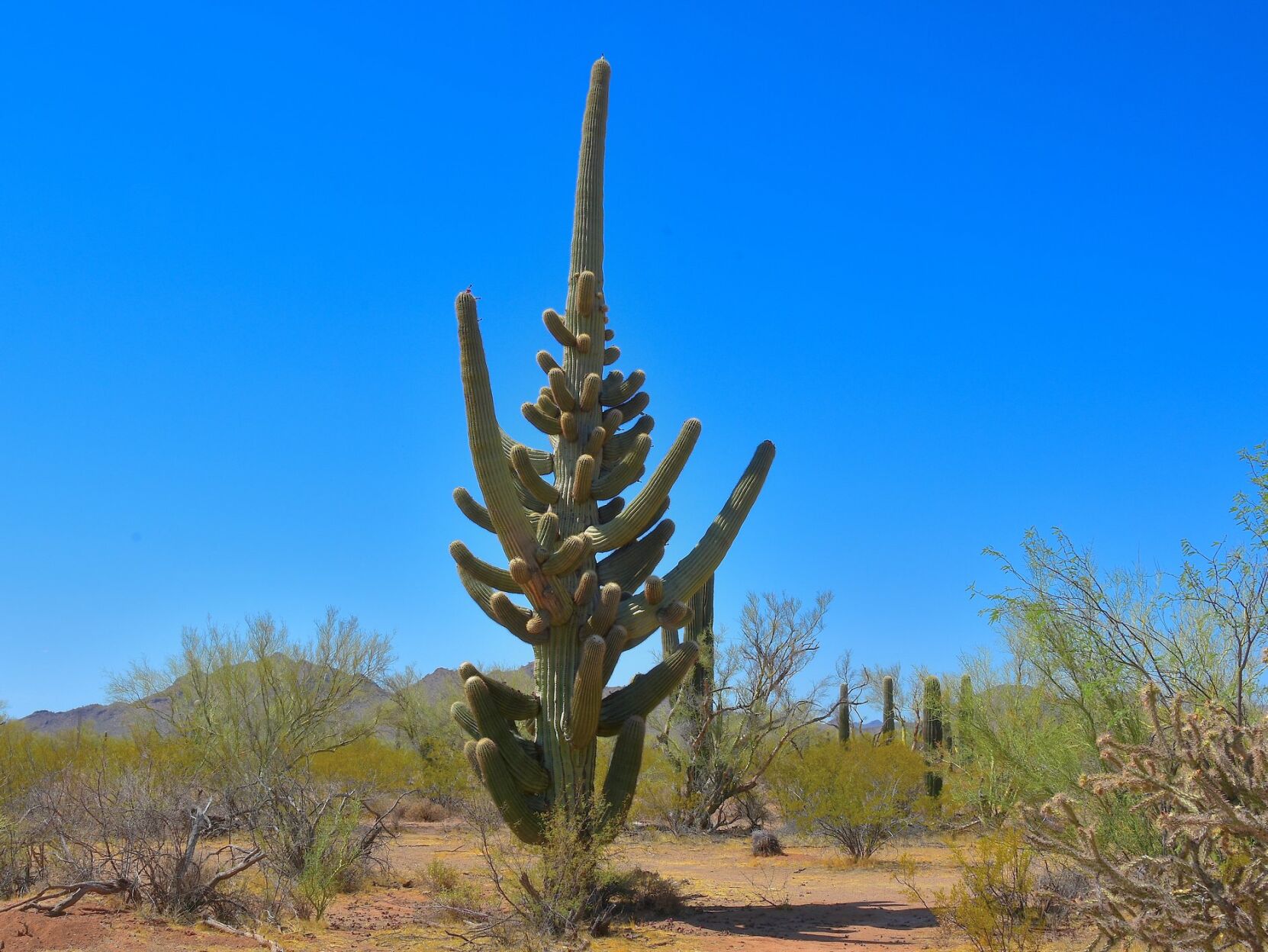
This photo was taken in Ironwood Forest National Monument, west of Marana.
It also takes a saguaro quite a while to grow its first arm, if it grows any at all.
"There's no hard and fast rule and there's exceptions to everything, but generally when they're like 75 years old they'll start producing arms," Swann says.
And the number of arms they grow largely depends on one thing: water.
"Since water is the primary limiting factor for them in the desert, in areas where they're getting more moisture they tend to grow more arms," Swann says. "As you're hiking around you'll notice there tends to be more arms on saguaros that are near washes, for example. So basically if the conditions are favorable and they can put that energy into reproduction (in other words if they're getting enough water they need to survive) then they're going to grow more arms."
This is also why saguaros at Saguaro National Park East in the Rincon Mountains, which tends to see more precipitation, grow faster than their friends at Saguaro National Park West in the Tucson Mountains.
"The growth rate of saguaros, is directly tied to the amount of rainfall, particularly summer rain. So they'll grow faster in wet years than they do in dry years," Swann says.
On average, a 20-year-old saguaro is around 8½ inches tall in the west district while a saguaro growing in the east district could be around 4 inches taller, he says.
But flowers are different

On the flip side, more water doesn't necessarily mean more saguaro blossoms.
"When you have warmer temperatures, you also tend to have more flowers," Swann says. "In years where we have more rain, the flowers tend to bloom later. And, interestingly, when we have more rain, we have fewer flowers — not sure exactly why you have fewer flowers when you have more rain but these warmer temperatures and drier winters seem to be increasing how early the saguaros bloom and how many blooms we get."
In 2022, though, cactus experts reported a below-average number of saguaro blooms. Find out more about that here.
Why you might see sad-armed saguaros

This specimen, sometimes called the “pooped-out saguaro,” has its four main limbs hanging toward the ground rather than standing tall.
You're likely never to find any two saguaros that are exactly alike. Some have tons of arms. Some have none. Some grow arms all over the place. Others sprout arms from one spot on their stem.
Swann doesn't know what causes arms to grow from different parts of the stem, but says the arms are usually distributed to help a saguaro keep its balance.
"You don't want to have a lot of arms coming out on one side in the upper part of the cactus because it would unbalance the cactus and it might not be as stable," he says
And if you happen across a saguaro with sad, drooping arms instead of arms that grow up, at some point in its life, it likely experienced a freeze event.
"During severe freeze events the saguaro is really kind of struggling for its life," Swann says.
A freeze event, he says, is when temperatures are below freezing for more than 36 hours straight.
"When that happens you start to get damage to the tissue in the saguaro and where the tissue in the arm meets the main steam is a zone of weakness and the tissue actually starts to kind of break down and the arm will actually rotate and turn down."
Many of the saguaros with droopy arms you see now were damaged by freeze events that happened in the '70s and some were damaged after a freeze event in 2011, he says.
But even damaged and droopy arms can still produce flowers.
"Some of the coolest photographs you'll see of saguaro flowers are people that take pictures of the branches that are only 2 or 3 feet off the ground," Swann says. "And when you're hiking around and you happen upon one of these saguaros you can often stick your face right in the flowers which is really cool."
Saguaros are slow pokes

These 10 year-old saguaros were grown from seeds.
Those small "baby" saguaros you see out on a hike are probably much older than you might imagine.
"One of the things that not everybody knows about baby saguaros is that they are very, very slow growing," Swann says. "... When you look at a saguaro that's 2 feet tall, most people think that's a baby saguaro, but that saguaro could be 30 years old."
He says an average 5-year-old saguaro is between ⅓ to ½ inch tall and a 10-year-old is around 1½ to 3 inches tall.
"So you don't even see them unless you've got really good eyes, especially if they're just growing up through the leaf litter underneath nurse trees ... until they're at least 10 years old," Swann says.
They start growing more quickly between ages 30-100 and then their growth rate starts to slow down again as they start putting more energy into their arms, he says.
Looking for young saguaros and tracking how many there are is one of the things Saguaro National Park looks for during its saguaro census which happens every 10 years.
"In general, since the mid-1990s, we've had a real slowdown in the number of very young saguaros that are surviving," Swann says. "We had a really good period in the '60s all the way through the '80s and into the '90s, but then the last 25 to 30 years, there's been a real slowdown in the number of babies and we attribute that to the long-term drought that we've been in."
Saguaro babies are much less drought tolerant than their elders.
"When you're a little saguaro, you can't store enough water to survive during the really dry periods and so you kind of rely on having some moisture in the soil, and it's one of the reasons why they like the nurse trees because they provide some extra moisture," Swann says.
The deal with crested saguaros

This cristate, or crested, saguaro in Sabino Canyon near Tucson is putting on a good bloom. Photo taken June 3, 2014. Photo by Doug Kreutz / Arizona Daily Star
"Saguaros are one of the most studied plants in the world," Swann says. "There are hundreds of scientific papers written about them but there's still a lot of things that we're still learning about them which is kind of cool."
Case in point, the crested saguaro, which does whatever it wants.
These rare specimens grow in a fan-like shape and the cause of this is one of the Sonoran Desert's unsolved mysteries.
"The short answer is we don't know," Swann says.
Something triggers it to grow the way it does, and there is research happening at the University of Arizona looking at the genetics of crested saguaros, but for now the cause is still unknown.
"It could be a fungi, it could be strictly related to genetics, it could be related to some other kind of environment factor that disturbs it and causes that abnormal growth ... but it's very rare," Swann says.


